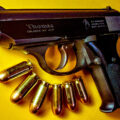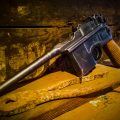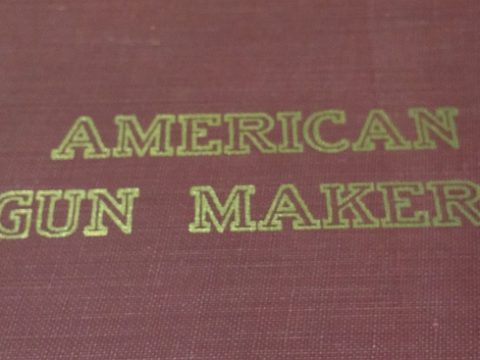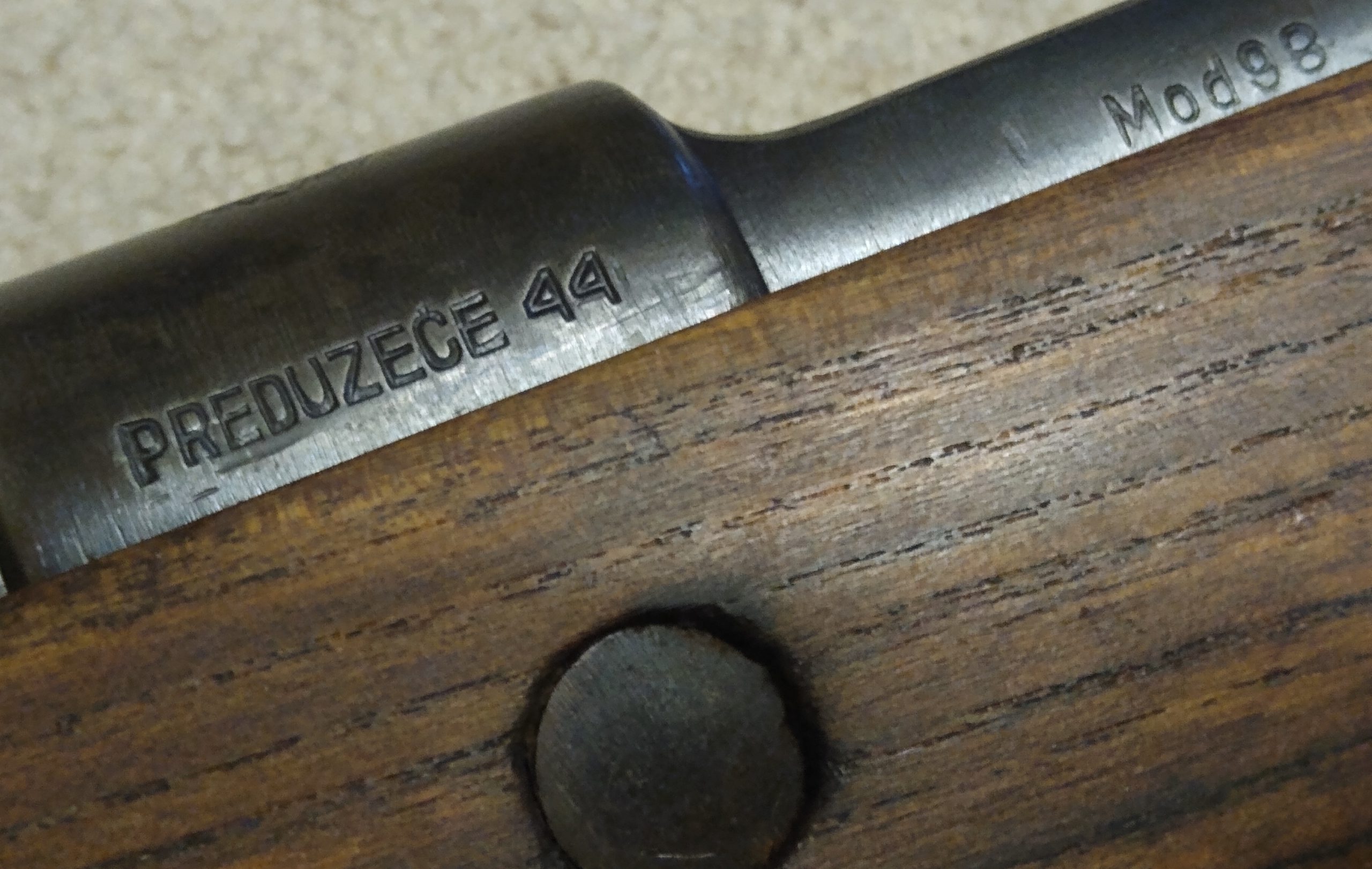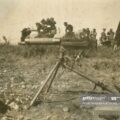For the sake of brevity, the author has split the Locked Systems portion of this article into two parts. Part 1 deals many of the less common subcategories of locking systems, including gas operated guns, fixed barrel guns, and long recoil guns. For a review of short recoil operated guns, please refer to the following article “Pistol Phylogeny Part 5 – Locked (Short Recoil)”.
*-*-*-*-*
Locked breech systems add another wrinkle to the discussion, in that they include mechanically locking components. This means that these systems can be categorized both by the type of locking mechanism they employ, and by the manner in which they drive the system to unlock it. This can, and has, led to a wide variety in design combinations that can make categorization a bit difficult. The author has finally ordered his mind to first separate them by the overall operating philosophy (gas or recoil driven), secondly by the method in which philosophy is employed, and thirdly by the mechanism used to lock and unlock the gun itself. For the sake of brevity, he has also limited both his collecting and writing to guns that were commercially available in numbers as to be “reasonably” available on the open market. He would certainly appreciate information on combinations appropriate to these criteria that he may have missed.
The advantage of locked breech systems comes from the strength inherent to the locking itself. Containing the gas pressure of a fired cartridge makes for a delicate balancing act in unlocked systems, and some rather clever physics equations in delayed systems. In locked systems, the pressure is inherently contained, and the engineering is left to focus on how and when and by what force the barrel and breechface are separated.

Gas Operated
Gas operation is a set of systems far more common in the world of long arms, with relatively few examples of gas operated pistols; and of those, all but a few have remained in the mere prototype phase. In fact, the author is currently aware of only two “reasonably” available models in this category, and both are interestingly in “magnum” chamberings. Perhaps after tapping and siphoning the gas off the barrel, more traditional pistol rounds lack the needed “umph” to pneumatically drive the system. Or perhaps gas operation is just too dirty, hot, and complex for most handguns to bother with when the job can be done any number of other ways.
In either case, gas operation differs from gas delay pretty starkly. In gas delay systems, the gas is used to exert a force against the slide and counter/delay its rearward travel. In gas operated systems, gas pressure is employed in an opposite manner, to accelerate the slide/bolt into the rearward direction. In long arms this traditionally takes several forms – gas flappers, gas traps, short stroke pistons, long stroke pistons, direct impingement, the AR platform modified direct impingement, etc. However, in pistols, these traditional categories are a good deal muddier…
Long Stroke (with Rotating Bolt)
For reasons that will soon become apparent, we must briefly describe direct impingement. This is the most straight forward form of gas operation. In this setup, gas is tapped out of the barrel, down a tube, and directly onto/into the slide/bolt/bolt-carrier, which is then forced rearward until the gun unlocks and opens. Long stroke systems work similarly, except instead of venting the gas back into the slide/bolt-carrier itself, it is used to pressurize a gas chamber and drive a piston and operating rod backwards, which is in turn attached to the bolt-carrier, which moves and unlocks the action, etc.
One such gun that operates similar to this manner is the meme-y-ist of pistols – the Desert Eagle. In this gun, the gas is actually siphoned off directly in front of the chamber, before running forward in a tube parallel under the barrel. At the front end of the barrel, the gas is vented downward into a chamber that is sealed on the rear end with a piston head attached directly to the slide. The gas pressure then forces the slide rearward against its hefty mass and spring pressure. As the slide begins to move backwards, the rotating bolt head (very similar to an AR) remains locked into the otherwise immobilized barrel trunnion. The slide (acting as the BCG would in an AR) rotates the bolt head in a camming action as the two are drawn apart, until finally the bolt turns enough to unlock and open. To ensure the bolt head remains aligned during the rest of the operation, a spring-loaded plunger (otherwise pressed back into the slide when in battery) temporarily rides forward and in between two of the locking lugs.
The consternation here is whether this design is more akin to a direct impingement or long stroke action. The piston head is a very short piece such that the slide touches the gas chamber, and since the slide is all one piece, it could be argued that the gas is directly impinging on the slide. That said, the piston head is actually a separate piece affixed to the slide, and the two forward extending slide arms can be seen to operate as an operating rod, thus providing a basis for a long stroke categorization. Perhaps this is splitting hairs, but the author has determined to call it a long stroke system, because it sounds more symmetric when paired with the short stroke gun that shall be addressed below.
(It should be noted that the author does not consider himself to be totally ridiculous, as he did limit himself to the far more practical and comfortable .357 magnum version of the gun.)


Long Stroke (with Roller Locks)
While the Desert Eagle is well known in pop culture, the Wolf Ultramatic is relegated to a much less widely known position in history. Similar to the “Deagle”, the Ultramatic taps gas out of the barrel (but this time nearer the muzzle) and uses the pressure to actuate an operating rod riding over the barrel. However, unlike the Desert Eagle, the locking mechanism in the Ultramatic has been deemed a “Torus Segment” locked design… The author is admittedly at a bit of a loss to describe this as videos on the subject are sparse, and few of those dare to attempt to disassemble or explain the complex interaction of parts that make up the gun. From the few references available, the locking mechanism appears to likely be similar to the roller locked systems identified in Part 5, just with a fixed barrel and gas driven function more akin to that in a machine gun like an MG-42. Another opportunity for much more learning…
Short Stroke
Much less questionable in the nomenclature of its design, is the Wildey Survivor. This similarly magnum hand cannon utilizes a short stroke system in which gas is vented from the barrel, past a gas regulator, and into a chamber built into the gas piston. The piston is sealed by machined surfaces on the barrel and gas regulator, and gas pressure drives it backwards sharply. The piston is driven into the slide, and moves it for a short distance before reaching its rearward extent of travel. The slide absorbs enough momentum from the brief strike to carry it the rest of the way rearward.
The bolt of the gun is locked into the barrel extension by two locking lugs on either side. As the slide travels back, a cam track cut into the top of the slide engages with the cam pin in the bolt. This rotates the bolt out of lock and frees it to cycle with the slide.
The difference between long and short stroke gas operation has to do with how far back the piston/operating rod travel. In a long stroke system, these are generally attached to the rest of the rearward cycling parts, and they move the full length of the action. In a short stroke system, the piston only travels a much shorter distance, essentially punching the cycling parts into motion, but not following through with them for the whole stroke.


Recoil Operated
While gas operation of locked breech auto-loading systems are significantly more common in long arms than handguns, the opposite is true for locked recoil operated systems. There are certainly a healthy number of long arms that have used these systems, but as most of the designs to follow include the movement of the barrel as a critical component, making rifles and shotguns with so many moving parts fell mostly out of favor in the first half of the 20th century. These considerations are far less challenging to adapt to handguns, as their size, recoil energies, and acceptable level of accuracy are all typically smaller. While many larger machine guns, cannons, etc. utilize recoil systems, these are often more specialized and emplaced, and for the common collector, locked recoil guns most often take the form of pistols.
Recoil operation can be compared to direct blow back to understand the relatively simple concept – rearward directed recoil energy is used to open the breech. However, as already described, locked breech guns must additionally find a way to decouple the barrel and breechface safely. How this is done is the subject of a myriad of patents and designs, many of which are categorized as follows.
Inertia Locked
The journey through the actions of locked recoil driven pistols begins on the “is that really locked?” end of the spectrum, with the inertia locked system of the Benelli B series of pistols. In fact, these guns are most commonly identified as delayed systems, which does also hold some valid points. These guns would best compare it to a 1980s Italian sports car – a sleek, smooth, and stylish design covering a series of esoteric features that result in simultaneous genius and insanity (for instance, the gun boasts an elegant loaded chamber indicator… that can only be viewed by looking directly down the slide from the muzzle end…). But the author digresses…
When at rest, the recoil spring brings the slide and interlocked rear block fully forward; however, the breechface isn’t machined into the slide, and instead the slide presses a semi-free-floating bolt forward and into battery against the fixed barrel, which is integral to the frame. The rear of the bolt includes a flapper lever, that when in battery becomes wedged into the rear of the slide; this in turn cams the rear of the bolt down aligning it with an angled locking surface in the frame. At the point of firing, recoil energy attempts to blow the bolt rearward, and does so for the space of about a millimeter, before the bolt becomes tenuously locked down into the frame by virtue of the downward camming action of the lever. As the lever wedges the bolt down, it also presses rearward on the slide. Inertia is transferred into the slide which begins to move on its own. Once the slide begins to move, the downward wedging force from the lever is relieved, and the bolt is allowed to slide up and out of lock with the frame to keep cycling. If the remaining recoil force of the round weren’t enough to fully drive the bolt back, a groove on the “ceiling” of the slide will pick up an extension on top of the bolt on its way past, thus ensuring the bolt is drawn fully to the rear.
The aforementioned Mr. McCollum has identified this as essentially physics “magic” which seems an apt description. The question as to if the gun is a locked or delayed is somewhat arguable based the definitions the author has provided for each. The question would come down to the point in firing where the slide begins to move. Once the wedge is eliminated, does the force of recoil cause the bolt to slip out of the angled cut in the frame, thus opening from the force within the chamber as a delayed action? Or once wedged downward and held under pressure, would the bolt remain so locked if not for the slide pulling it upwards and dragging it rearward, thus being opened by the external force of the slide yanking it along in a locked fashion? The manufacturer doesn’t clear this up at all; the manual calls the system a “delayed blow-back Locking System”, so that is no help. Ultimately, it would seem to be impossible to know for sure without some extensive testing that could permanently damage the gun, and is unlikely to be carried out by any of their honored owners… a sort of Schrodinger’s pistol scenario.
That all said, the author’s own ill-fated experience with a B76 pistol that unfortunately beat its own locking surfaces to death, demonstrates that a significant amount of the firing energy is drained into the frame through the locking surface. His subsequent acquisition of a B82 pistol and animating of the firing process, has however left his mind on the subject thoroughly undecided. This design seems to straddle the line between delayed and locked, but it is included here due to its similarity with the following “Hesitation Lock”.


Hesitation Locked
John Peterson’s hesitation lock is another example of something easier to understand than to explain. It was used to great effect in the Remington 51 pistol, and to much more lackluster effect in the more recent Remington R51 reimagining. The concept of the hesitation lock bares significant similarity to the inertia locked design above, in that it doesn’t fully lock until recoil energy is applied. The ultimate opening is accomplished by the transfer of inertia into the slide which then pulls the bolt out of lock.
At rest the recoil spring around the non-moving barrel presses the slide forward. This interlinks with the bolt and pulls it forward into battery against the barrel; this position also lowers the tail of the bolt, aligning it with a cutout in the frame. When fired, recoil energy from within the chamber presses the bolt rearward, which in turn presses the slide rearward against the recoil spring. In this state, the gun is operating in a direct blow back manner; however, this changes when after only a short distance, the downward hanging tail of the bolt strikes a locking surface on the frame. This locks the gun, albeit in a slightly opened position. The inertia already imparted to the slide allows it to continue rearward on its own, and as it does so, it eventually cams the rear of the bolt upwards and out of lock, thus freeing the action to fully open and cycle.
The outstanding question that the internet video commentary on the gun had left the author in wonder about, has to do with the hesitation period between when the gun actually locks and unlocks. During this phase the rear of the case is presumably partially withdrawn from the chamber. Does this, as some have suggested allow some gas and pressure to vent around the case and into the action, or does the pressure keep the casing form fitted to the chamber sealing the gasses in? Limited testing by the author with a piece of paper held near the ejection port would seem to indicate that the latter is true, though not definitive.


Multi-Chambered
Of the plethora of semi-automatic handguns that have been designed and marketed, they virtually all have one thing in common: they feed from a magazine through a single chamber that cycles open and closed during operation. But a notable exception to this are semi-automatic guns with multiple chambers… six chambers, in fact… semi-automatic revolvers.
The author is aware of two examples of these. The British Webley-Fosbery is the earlier example from the very early 1900s, with the Italian Mateba 6 Unica being far more recent. Both guns work in essentially the same fashion, splitting the frame into upper and lower portions, with the upper reciprocating against a recoil spring over top of the lower. As the opposing recoil and spring forces cycle the barrel, cylinder, and upper frame back and forth, their interaction with the comparatively immobile lower frame ratchets the cylinder to the next position and re-cocks the hammer for the next single action shot. The Webley accomplishes this via a zig-zag cam track carved on the exterior of the cylinder, while the Mateba utilizes a more common pawl design to rotate the cylinder from the rear.
The question here is where these anomalies fit into the phylogenetic tree. Revolvers do technically keep the chamber, barrel, and breechface locked together in alignment throughout all of firing. The automatic rotation of the cylinder (the action making them semi-automatic) is facilitated by the normal force of the lower frame, thus further meeting the previous definitions for locking set above. And finally, the cycling (rotation) of the action (cylinder) is driven by recoil energy. These three things, while unconventionally combined, would seem to appropriately place these handguns here in the lineup.
Long Recoil
Rounding out the list of less common locked breech, recoil operated pistols, is the category of long recoil systems. However, this also marks the first discussion of a locked and magazine fed system to have a moving barrel – something that will be far more common in Part 5 of this article.
In these systems, when fired, the barrel and breechface remain locked together as they both move rearward under recoil force. They remain locked until they reach the full rearward extent of travel, with a distance moved of greater than the length of the cartridge. At this point a catch is tripped by components within the comparatively immobile frame, and the action unlocks allowing the barrel to return forward into position under its own spring pressure. As the barrel moves forward, the bolt is caught in the rear position, where it retains a grip on the spent casing. Once the barrel clears the casing, the empty shell is expelled from the gun, the bolt is then tripped to return forward into battery behind the barrel under the power of its own separate recoil spring, and in so doing it strips and loads another cartridge into the chamber. Simple.
These systems have one very notable advantage, in that the breech remains closed for a comparatively very long time, thus ensuring the pressure has dropped well into the safety margin before opening. This feature makes a bit more sense in the higher pressure world of rifle and shotgun cartridges, and as such most long recoil designs were focused here, as opposed to the relatively low pressures of handguns. Even at that, the complexity of long recoil systems fell out of favor in the first half of the 20th century, and few modern guns still use these designs.
Nevertheless, a few attempts have been made at creating long recoil operated handguns, only one of which found moderate success – the Frommer Stop. The operation of this odd looking little gun is as described above, but it pairs this with a rotating bolt head design of locking system. The force of the recoil drives back both bolt and barrel, but as the barrel begins to move forward again, it pulls on the bolt head it is locked to. As the bolt head is pulled out of the temporarily captive bolt carrier, it is drawn along a cam track in the bolt that rotates the bolt head and unlocks the gun. To the author’s knowledge (and collecting relief) this is the lock up used in the handful of other long recoil pistol designs as well.



